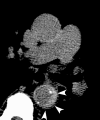Recommendations for accurate CT diagnosis of suspected acute aortic syndrome (AAS)--on behalf of the British Society of Cardiovascular Imaging (BSCI)/British Society of Cardiovascular CT (BSCCT)
- PMID: 26916280
- PMCID: PMC4985448
- DOI: 10.1259/bjr.20150705
Recommendations for accurate CT diagnosis of suspected acute aortic syndrome (AAS)--on behalf of the British Society of Cardiovascular Imaging (BSCI)/British Society of Cardiovascular CT (BSCCT)
Abstract
Accurate and timely assessment of suspected acute aortic syndrome is crucial in this life-threatening condition. Imaging with CT plays a central role in the diagnosis to allow expedited management. Diagnosis can be made using locally available expertise with optimized scanning parameters, making full use of recent advances in CT technology. Each imaging centre must optimize their protocols to allow accurate diagnosis, to optimize radiation dose and in particular to reduce the risk of false-positive diagnosis that may simulate disease. This document outlines the principles for the acquisition of motion-free imaging of the aorta in this context.
Figures



References
-
- Olsson C, Thelin S, Ståhle E, Ekbom A, Granath F. Thoracic aortic aneurysm and dissection: increasing prevalence and improved outcomes reported in a nationwide population-based study of more than 14,000 cases from 1987 to 2002. Circulation 2006; 114: 2611–8. doi: 10.1161/CIRCULATIONAHA.106.630400 - DOI - PubMed
Publication types
MeSH terms
LinkOut - more resources
Full Text Sources
Other Literature Sources
Medical

